Comprehensive Analysis of Toyota's Supply Chain Management
VerifiedAdded on 2021/10/01
|23
|5985
|100
Report
AI Summary
This report provides a comprehensive analysis of Toyota's supply chain management (SCM). It begins with an overview of the company, including its vision, mission, and core values, and then delves into the strategic fit of its SCM, emphasizing the Toyota Production System (TPS) and lean manufacturing principles. The report examines the design of Toyota's supply chain network, highlighting its reliance on the Just-In-Time (JIT) system and the elimination of waste. It further explores the collaboration across the global supply chain, the sourcing and cooperation with suppliers, and the planning and coordination within the SCM. The report also analyzes forecasting, inventory management, transportation network design, and the role of information technology (IT). Finally, it assesses the level of sustainability in Toyota's supply chain and concludes with recommendations based on the findings. This report is a detailed examination of Toyota's SCM, providing insights into its strengths and areas for potential improvement.
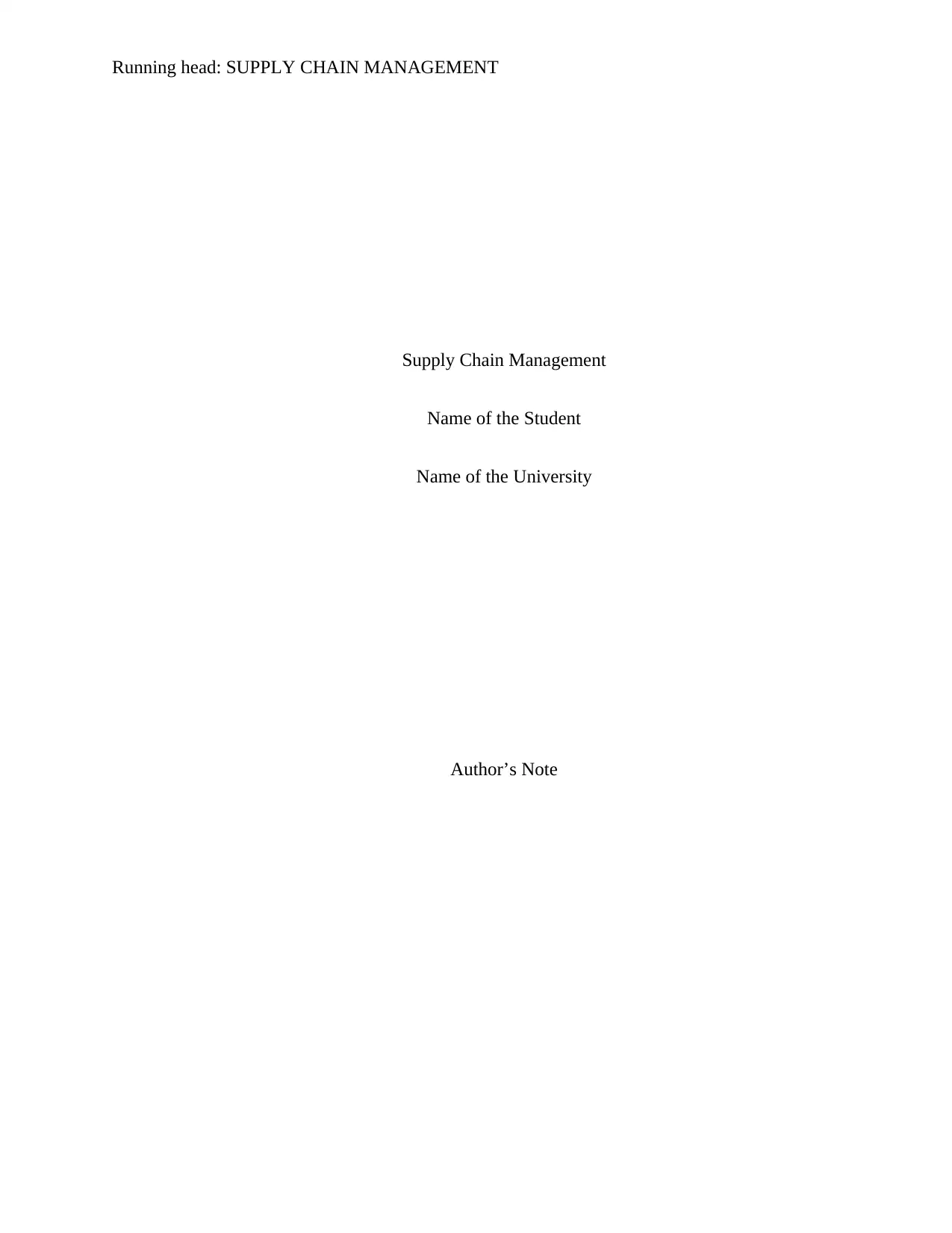
Running head: SUPPLY CHAIN MANAGEMENT
Supply Chain Management
Name of the Student
Name of the University
Author’s Note
Supply Chain Management
Name of the Student
Name of the University
Author’s Note
Paraphrase This Document
Need a fresh take? Get an instant paraphrase of this document with our AI Paraphraser
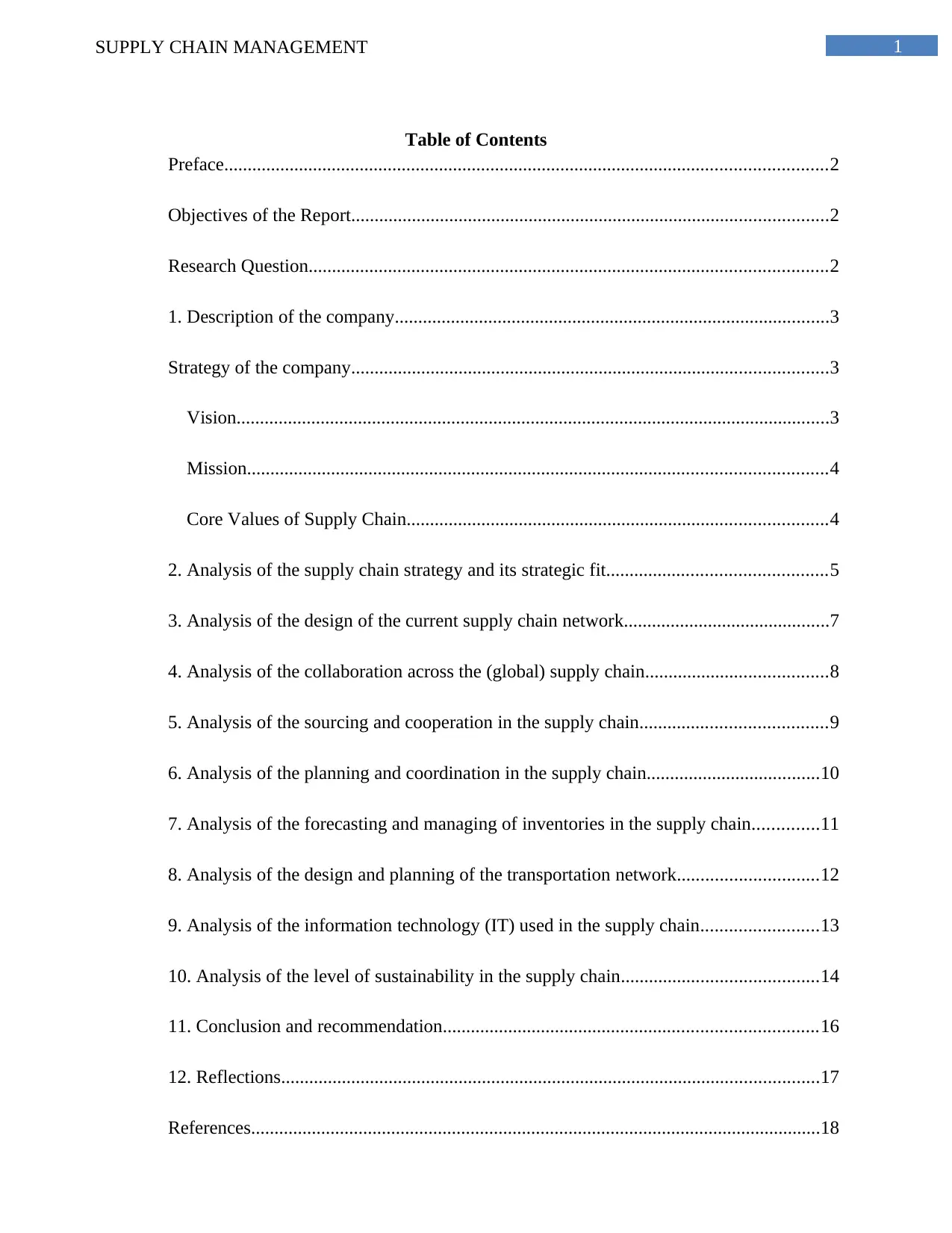
1SUPPLY CHAIN MANAGEMENT
Table of Contents
Preface.................................................................................................................................2
Objectives of the Report......................................................................................................2
Research Question...............................................................................................................2
1. Description of the company.............................................................................................3
Strategy of the company......................................................................................................3
Vision...............................................................................................................................3
Mission............................................................................................................................4
Core Values of Supply Chain..........................................................................................4
2. Analysis of the supply chain strategy and its strategic fit...............................................5
3. Analysis of the design of the current supply chain network............................................7
4. Analysis of the collaboration across the (global) supply chain.......................................8
5. Analysis of the sourcing and cooperation in the supply chain........................................9
6. Analysis of the planning and coordination in the supply chain.....................................10
7. Analysis of the forecasting and managing of inventories in the supply chain..............11
8. Analysis of the design and planning of the transportation network..............................12
9. Analysis of the information technology (IT) used in the supply chain.........................13
10. Analysis of the level of sustainability in the supply chain..........................................14
11. Conclusion and recommendation................................................................................16
12. Reflections...................................................................................................................17
References..........................................................................................................................18
Table of Contents
Preface.................................................................................................................................2
Objectives of the Report......................................................................................................2
Research Question...............................................................................................................2
1. Description of the company.............................................................................................3
Strategy of the company......................................................................................................3
Vision...............................................................................................................................3
Mission............................................................................................................................4
Core Values of Supply Chain..........................................................................................4
2. Analysis of the supply chain strategy and its strategic fit...............................................5
3. Analysis of the design of the current supply chain network............................................7
4. Analysis of the collaboration across the (global) supply chain.......................................8
5. Analysis of the sourcing and cooperation in the supply chain........................................9
6. Analysis of the planning and coordination in the supply chain.....................................10
7. Analysis of the forecasting and managing of inventories in the supply chain..............11
8. Analysis of the design and planning of the transportation network..............................12
9. Analysis of the information technology (IT) used in the supply chain.........................13
10. Analysis of the level of sustainability in the supply chain..........................................14
11. Conclusion and recommendation................................................................................16
12. Reflections...................................................................................................................17
References..........................................................................................................................18
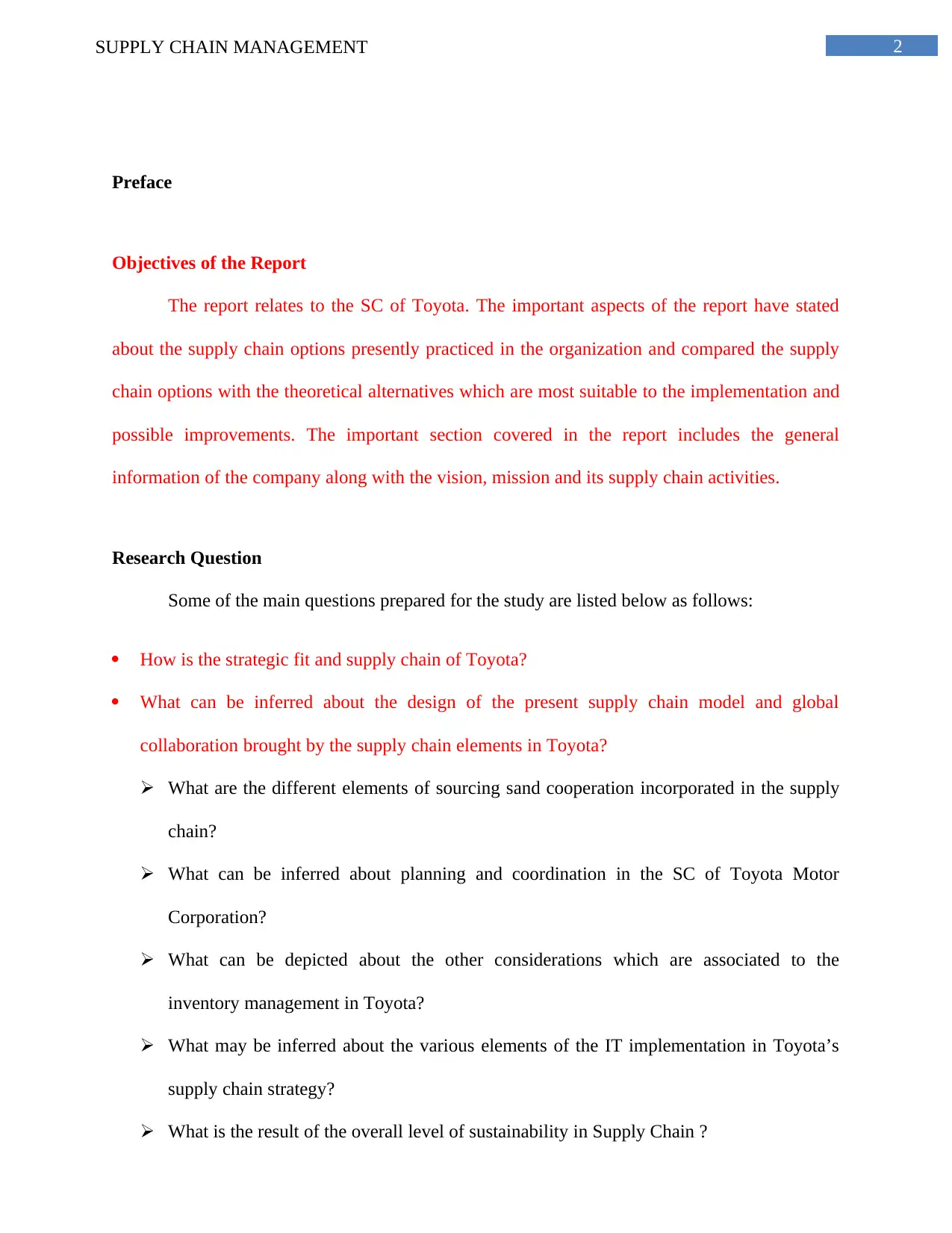
2SUPPLY CHAIN MANAGEMENT
Preface
Objectives of the Report
The report relates to the SC of Toyota. The important aspects of the report have stated
about the supply chain options presently practiced in the organization and compared the supply
chain options with the theoretical alternatives which are most suitable to the implementation and
possible improvements. The important section covered in the report includes the general
information of the company along with the vision, mission and its supply chain activities.
Research Question
Some of the main questions prepared for the study are listed below as follows:
How is the strategic fit and supply chain of Toyota?
What can be inferred about the design of the present supply chain model and global
collaboration brought by the supply chain elements in Toyota?
What are the different elements of sourcing sand cooperation incorporated in the supply
chain?
What can be inferred about planning and coordination in the SC of Toyota Motor
Corporation?
What can be depicted about the other considerations which are associated to the
inventory management in Toyota?
What may be inferred about the various elements of the IT implementation in Toyota’s
supply chain strategy?
What is the result of the overall level of sustainability in Supply Chain ?
Preface
Objectives of the Report
The report relates to the SC of Toyota. The important aspects of the report have stated
about the supply chain options presently practiced in the organization and compared the supply
chain options with the theoretical alternatives which are most suitable to the implementation and
possible improvements. The important section covered in the report includes the general
information of the company along with the vision, mission and its supply chain activities.
Research Question
Some of the main questions prepared for the study are listed below as follows:
How is the strategic fit and supply chain of Toyota?
What can be inferred about the design of the present supply chain model and global
collaboration brought by the supply chain elements in Toyota?
What are the different elements of sourcing sand cooperation incorporated in the supply
chain?
What can be inferred about planning and coordination in the SC of Toyota Motor
Corporation?
What can be depicted about the other considerations which are associated to the
inventory management in Toyota?
What may be inferred about the various elements of the IT implementation in Toyota’s
supply chain strategy?
What is the result of the overall level of sustainability in Supply Chain ?
⊘ This is a preview!⊘
Do you want full access?
Subscribe today to unlock all pages.

Trusted by 1+ million students worldwide
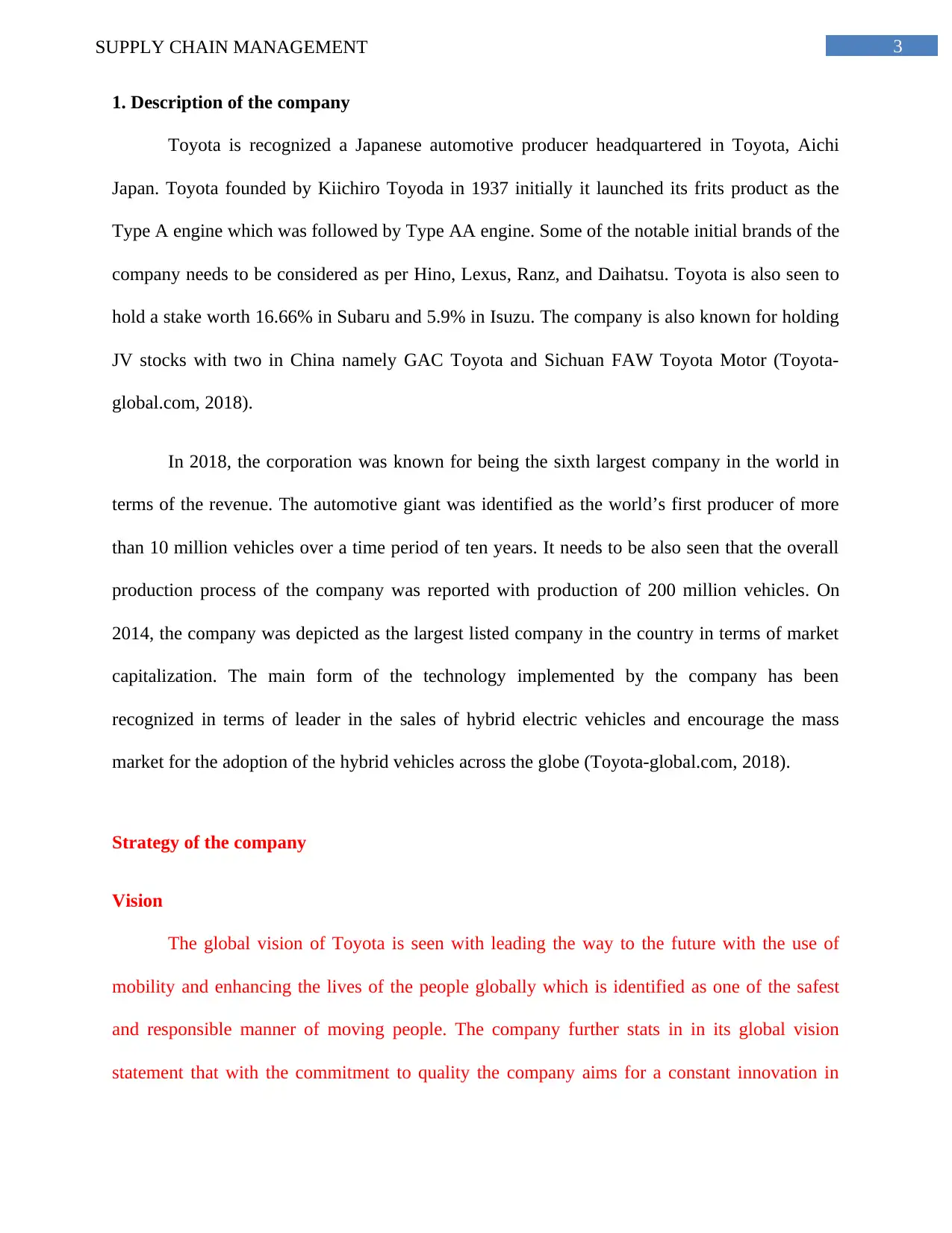
3SUPPLY CHAIN MANAGEMENT
1. Description of the company
Toyota is recognized a Japanese automotive producer headquartered in Toyota, Aichi
Japan. Toyota founded by Kiichiro Toyoda in 1937 initially it launched its frits product as the
Type A engine which was followed by Type AA engine. Some of the notable initial brands of the
company needs to be considered as per Hino, Lexus, Ranz, and Daihatsu. Toyota is also seen to
hold a stake worth 16.66% in Subaru and 5.9% in Isuzu. The company is also known for holding
JV stocks with two in China namely GAC Toyota and Sichuan FAW Toyota Motor (Toyota-
global.com, 2018).
In 2018, the corporation was known for being the sixth largest company in the world in
terms of the revenue. The automotive giant was identified as the world’s first producer of more
than 10 million vehicles over a time period of ten years. It needs to be also seen that the overall
production process of the company was reported with production of 200 million vehicles. On
2014, the company was depicted as the largest listed company in the country in terms of market
capitalization. The main form of the technology implemented by the company has been
recognized in terms of leader in the sales of hybrid electric vehicles and encourage the mass
market for the adoption of the hybrid vehicles across the globe (Toyota-global.com, 2018).
Strategy of the company
Vision
The global vision of Toyota is seen with leading the way to the future with the use of
mobility and enhancing the lives of the people globally which is identified as one of the safest
and responsible manner of moving people. The company further stats in in its global vision
statement that with the commitment to quality the company aims for a constant innovation in
1. Description of the company
Toyota is recognized a Japanese automotive producer headquartered in Toyota, Aichi
Japan. Toyota founded by Kiichiro Toyoda in 1937 initially it launched its frits product as the
Type A engine which was followed by Type AA engine. Some of the notable initial brands of the
company needs to be considered as per Hino, Lexus, Ranz, and Daihatsu. Toyota is also seen to
hold a stake worth 16.66% in Subaru and 5.9% in Isuzu. The company is also known for holding
JV stocks with two in China namely GAC Toyota and Sichuan FAW Toyota Motor (Toyota-
global.com, 2018).
In 2018, the corporation was known for being the sixth largest company in the world in
terms of the revenue. The automotive giant was identified as the world’s first producer of more
than 10 million vehicles over a time period of ten years. It needs to be also seen that the overall
production process of the company was reported with production of 200 million vehicles. On
2014, the company was depicted as the largest listed company in the country in terms of market
capitalization. The main form of the technology implemented by the company has been
recognized in terms of leader in the sales of hybrid electric vehicles and encourage the mass
market for the adoption of the hybrid vehicles across the globe (Toyota-global.com, 2018).
Strategy of the company
Vision
The global vision of Toyota is seen with leading the way to the future with the use of
mobility and enhancing the lives of the people globally which is identified as one of the safest
and responsible manner of moving people. The company further stats in in its global vision
statement that with the commitment to quality the company aims for a constant innovation in
Paraphrase This Document
Need a fresh take? Get an instant paraphrase of this document with our AI Paraphraser
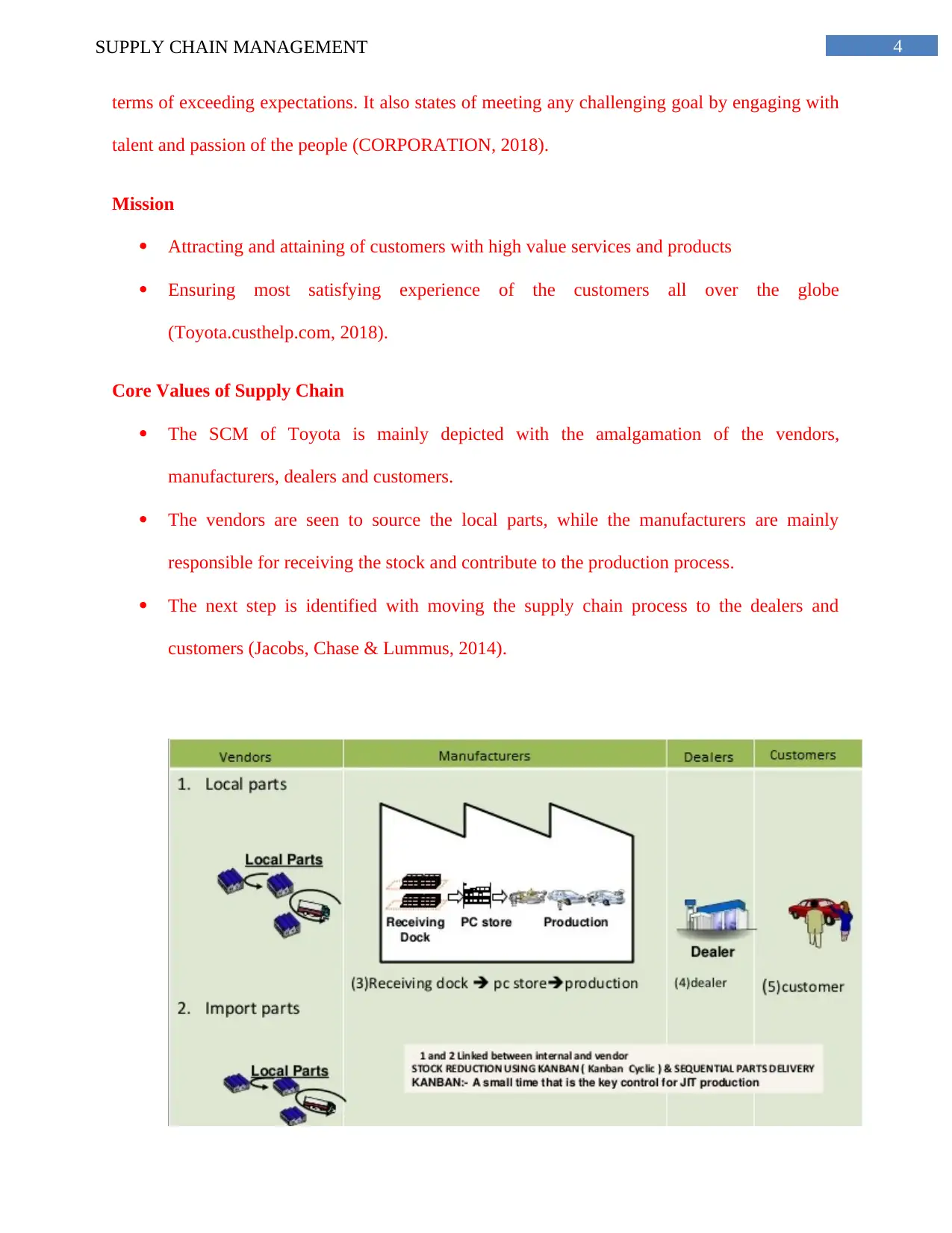
4SUPPLY CHAIN MANAGEMENT
terms of exceeding expectations. It also states of meeting any challenging goal by engaging with
talent and passion of the people (CORPORATION, 2018).
Mission
Attracting and attaining of customers with high value services and products
Ensuring most satisfying experience of the customers all over the globe
(Toyota.custhelp.com, 2018).
Core Values of Supply Chain
The SCM of Toyota is mainly depicted with the amalgamation of the vendors,
manufacturers, dealers and customers.
The vendors are seen to source the local parts, while the manufacturers are mainly
responsible for receiving the stock and contribute to the production process.
The next step is identified with moving the supply chain process to the dealers and
customers (Jacobs, Chase & Lummus, 2014).
terms of exceeding expectations. It also states of meeting any challenging goal by engaging with
talent and passion of the people (CORPORATION, 2018).
Mission
Attracting and attaining of customers with high value services and products
Ensuring most satisfying experience of the customers all over the globe
(Toyota.custhelp.com, 2018).
Core Values of Supply Chain
The SCM of Toyota is mainly depicted with the amalgamation of the vendors,
manufacturers, dealers and customers.
The vendors are seen to source the local parts, while the manufacturers are mainly
responsible for receiving the stock and contribute to the production process.
The next step is identified with moving the supply chain process to the dealers and
customers (Jacobs, Chase & Lummus, 2014).
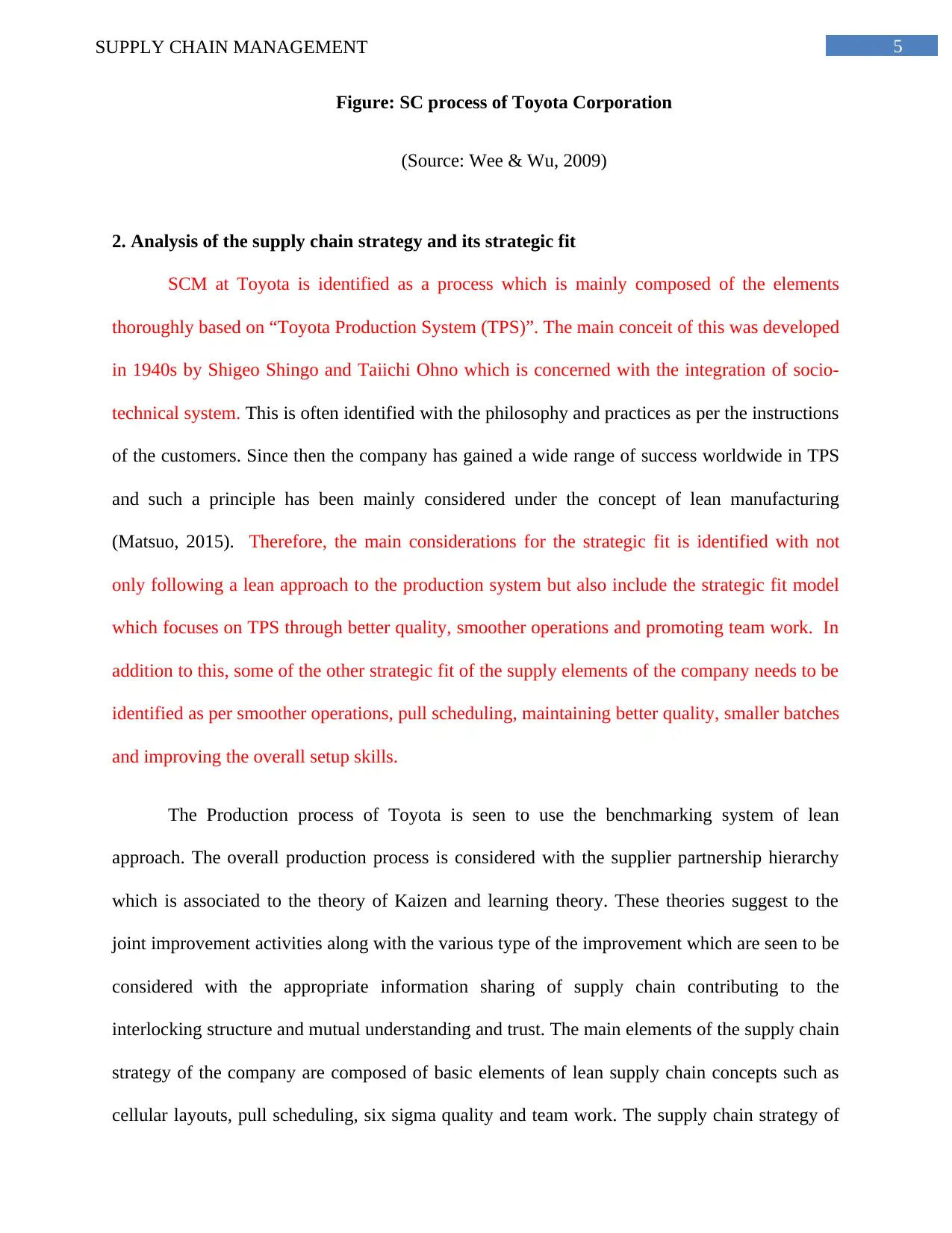
5SUPPLY CHAIN MANAGEMENT
Figure: SC process of Toyota Corporation
(Source: Wee & Wu, 2009)
2. Analysis of the supply chain strategy and its strategic fit
SCM at Toyota is identified as a process which is mainly composed of the elements
thoroughly based on “Toyota Production System (TPS)”. The main conceit of this was developed
in 1940s by Shigeo Shingo and Taiichi Ohno which is concerned with the integration of socio-
technical system. This is often identified with the philosophy and practices as per the instructions
of the customers. Since then the company has gained a wide range of success worldwide in TPS
and such a principle has been mainly considered under the concept of lean manufacturing
(Matsuo, 2015). Therefore, the main considerations for the strategic fit is identified with not
only following a lean approach to the production system but also include the strategic fit model
which focuses on TPS through better quality, smoother operations and promoting team work. In
addition to this, some of the other strategic fit of the supply elements of the company needs to be
identified as per smoother operations, pull scheduling, maintaining better quality, smaller batches
and improving the overall setup skills.
The Production process of Toyota is seen to use the benchmarking system of lean
approach. The overall production process is considered with the supplier partnership hierarchy
which is associated to the theory of Kaizen and learning theory. These theories suggest to the
joint improvement activities along with the various type of the improvement which are seen to be
considered with the appropriate information sharing of supply chain contributing to the
interlocking structure and mutual understanding and trust. The main elements of the supply chain
strategy of the company are composed of basic elements of lean supply chain concepts such as
cellular layouts, pull scheduling, six sigma quality and team work. The supply chain strategy of
Figure: SC process of Toyota Corporation
(Source: Wee & Wu, 2009)
2. Analysis of the supply chain strategy and its strategic fit
SCM at Toyota is identified as a process which is mainly composed of the elements
thoroughly based on “Toyota Production System (TPS)”. The main conceit of this was developed
in 1940s by Shigeo Shingo and Taiichi Ohno which is concerned with the integration of socio-
technical system. This is often identified with the philosophy and practices as per the instructions
of the customers. Since then the company has gained a wide range of success worldwide in TPS
and such a principle has been mainly considered under the concept of lean manufacturing
(Matsuo, 2015). Therefore, the main considerations for the strategic fit is identified with not
only following a lean approach to the production system but also include the strategic fit model
which focuses on TPS through better quality, smoother operations and promoting team work. In
addition to this, some of the other strategic fit of the supply elements of the company needs to be
identified as per smoother operations, pull scheduling, maintaining better quality, smaller batches
and improving the overall setup skills.
The Production process of Toyota is seen to use the benchmarking system of lean
approach. The overall production process is considered with the supplier partnership hierarchy
which is associated to the theory of Kaizen and learning theory. These theories suggest to the
joint improvement activities along with the various type of the improvement which are seen to be
considered with the appropriate information sharing of supply chain contributing to the
interlocking structure and mutual understanding and trust. The main elements of the supply chain
strategy of the company are composed of basic elements of lean supply chain concepts such as
cellular layouts, pull scheduling, six sigma quality and team work. The supply chain strategy of
⊘ This is a preview!⊘
Do you want full access?
Subscribe today to unlock all pages.

Trusted by 1+ million students worldwide
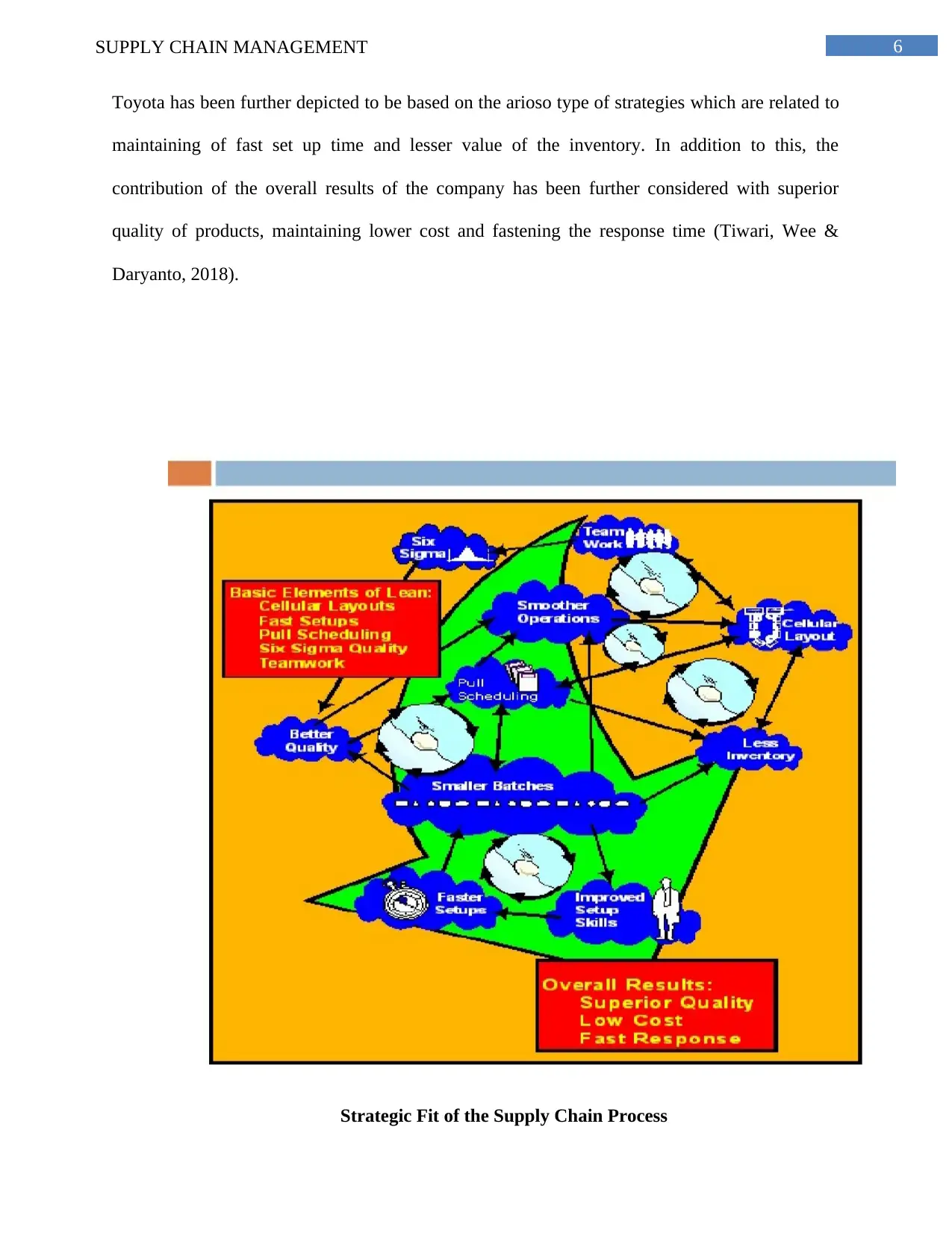
6SUPPLY CHAIN MANAGEMENT
Toyota has been further depicted to be based on the arioso type of strategies which are related to
maintaining of fast set up time and lesser value of the inventory. In addition to this, the
contribution of the overall results of the company has been further considered with superior
quality of products, maintaining lower cost and fastening the response time (Tiwari, Wee &
Daryanto, 2018).
Strategic Fit of the Supply Chain Process
Toyota has been further depicted to be based on the arioso type of strategies which are related to
maintaining of fast set up time and lesser value of the inventory. In addition to this, the
contribution of the overall results of the company has been further considered with superior
quality of products, maintaining lower cost and fastening the response time (Tiwari, Wee &
Daryanto, 2018).
Strategic Fit of the Supply Chain Process
Paraphrase This Document
Need a fresh take? Get an instant paraphrase of this document with our AI Paraphraser
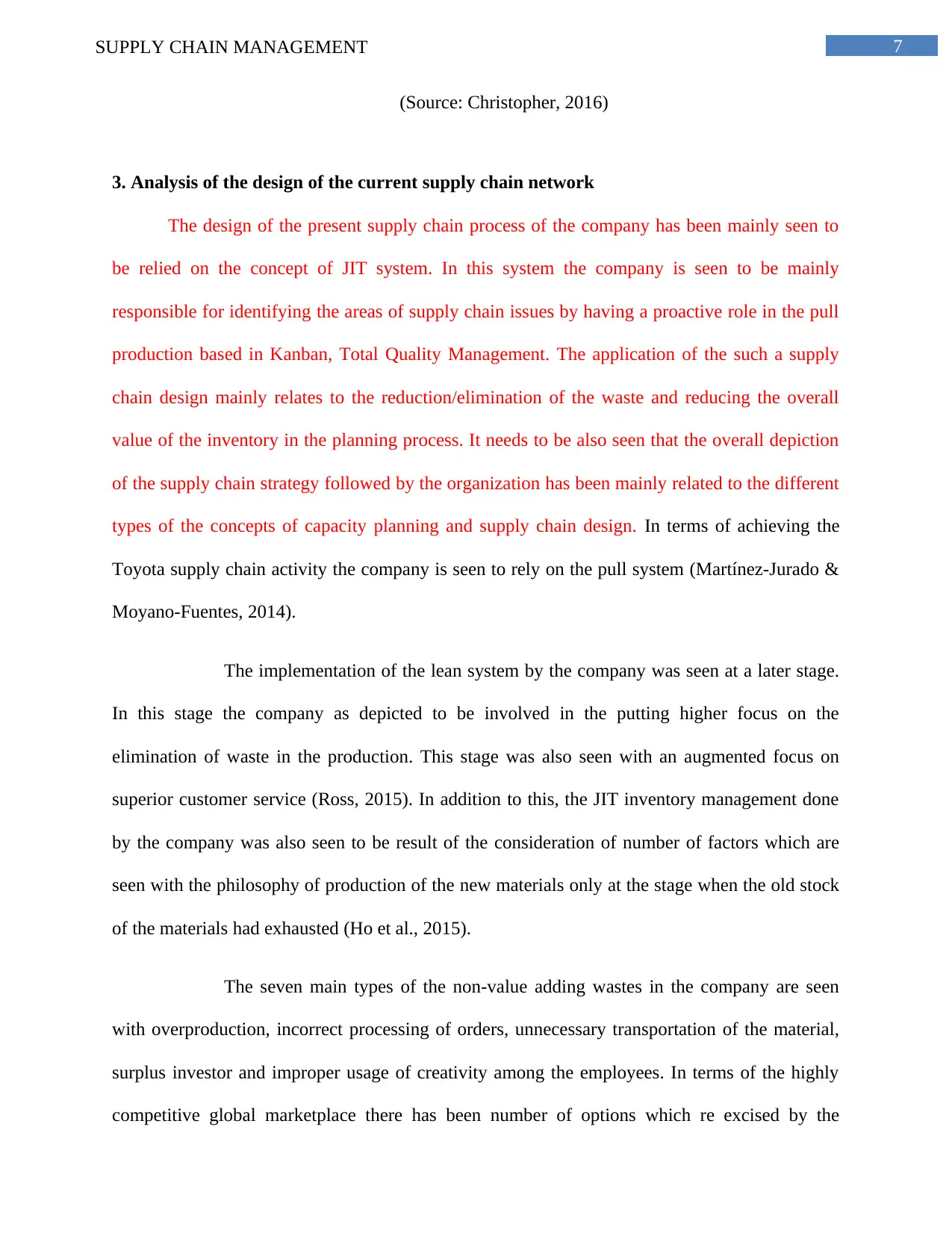
7SUPPLY CHAIN MANAGEMENT
(Source: Christopher, 2016)
3. Analysis of the design of the current supply chain network
The design of the present supply chain process of the company has been mainly seen to
be relied on the concept of JIT system. In this system the company is seen to be mainly
responsible for identifying the areas of supply chain issues by having a proactive role in the pull
production based in Kanban, Total Quality Management. The application of the such a supply
chain design mainly relates to the reduction/elimination of the waste and reducing the overall
value of the inventory in the planning process. It needs to be also seen that the overall depiction
of the supply chain strategy followed by the organization has been mainly related to the different
types of the concepts of capacity planning and supply chain design. In terms of achieving the
Toyota supply chain activity the company is seen to rely on the pull system (Martínez-Jurado &
Moyano-Fuentes, 2014).
The implementation of the lean system by the company was seen at a later stage.
In this stage the company as depicted to be involved in the putting higher focus on the
elimination of waste in the production. This stage was also seen with an augmented focus on
superior customer service (Ross, 2015). In addition to this, the JIT inventory management done
by the company was also seen to be result of the consideration of number of factors which are
seen with the philosophy of production of the new materials only at the stage when the old stock
of the materials had exhausted (Ho et al., 2015).
The seven main types of the non-value adding wastes in the company are seen
with overproduction, incorrect processing of orders, unnecessary transportation of the material,
surplus investor and improper usage of creativity among the employees. In terms of the highly
competitive global marketplace there has been number of options which re excised by the
(Source: Christopher, 2016)
3. Analysis of the design of the current supply chain network
The design of the present supply chain process of the company has been mainly seen to
be relied on the concept of JIT system. In this system the company is seen to be mainly
responsible for identifying the areas of supply chain issues by having a proactive role in the pull
production based in Kanban, Total Quality Management. The application of the such a supply
chain design mainly relates to the reduction/elimination of the waste and reducing the overall
value of the inventory in the planning process. It needs to be also seen that the overall depiction
of the supply chain strategy followed by the organization has been mainly related to the different
types of the concepts of capacity planning and supply chain design. In terms of achieving the
Toyota supply chain activity the company is seen to rely on the pull system (Martínez-Jurado &
Moyano-Fuentes, 2014).
The implementation of the lean system by the company was seen at a later stage.
In this stage the company as depicted to be involved in the putting higher focus on the
elimination of waste in the production. This stage was also seen with an augmented focus on
superior customer service (Ross, 2015). In addition to this, the JIT inventory management done
by the company was also seen to be result of the consideration of number of factors which are
seen with the philosophy of production of the new materials only at the stage when the old stock
of the materials had exhausted (Ho et al., 2015).
The seven main types of the non-value adding wastes in the company are seen
with overproduction, incorrect processing of orders, unnecessary transportation of the material,
surplus investor and improper usage of creativity among the employees. In terms of the highly
competitive global marketplace there has been number of options which re excised by the
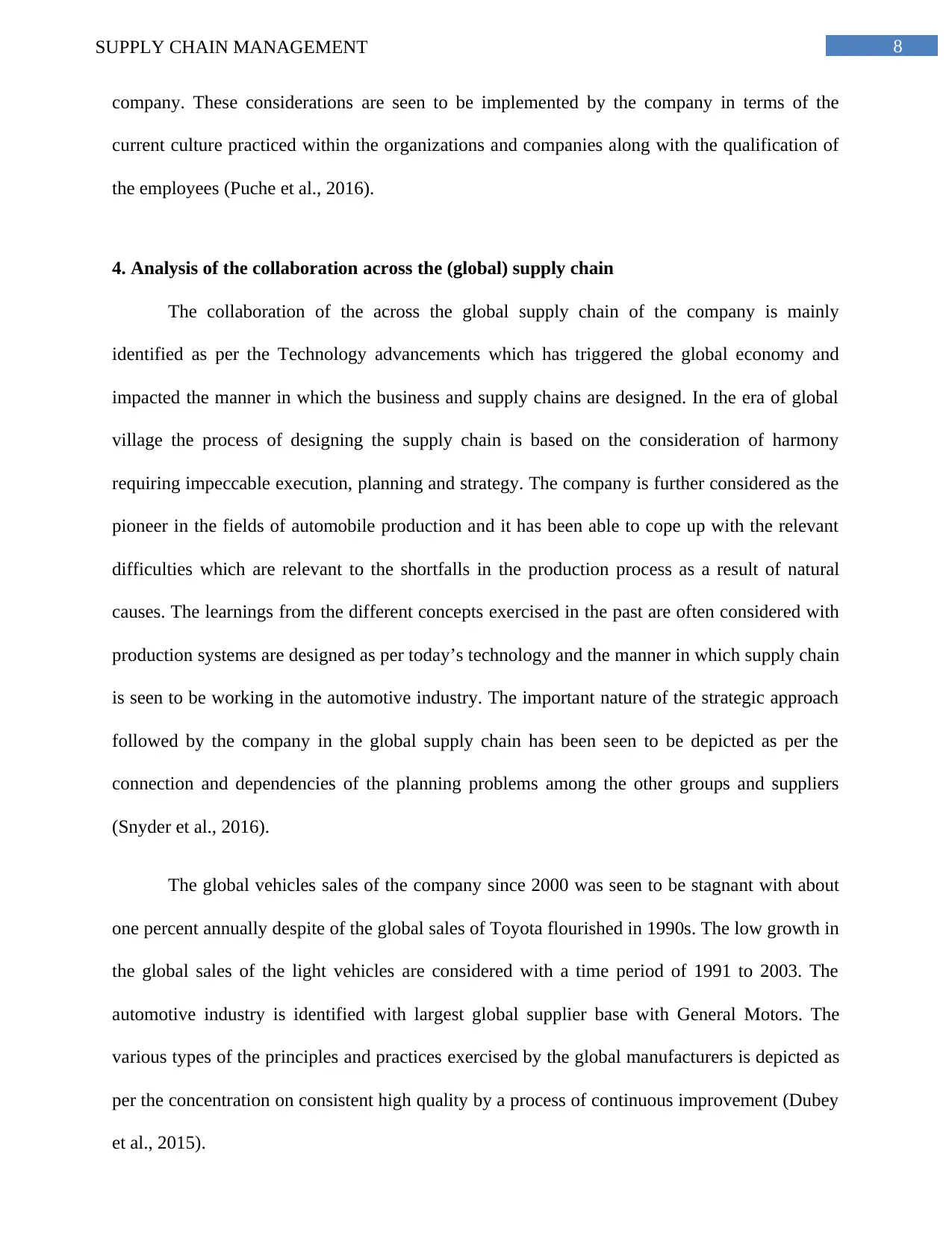
8SUPPLY CHAIN MANAGEMENT
company. These considerations are seen to be implemented by the company in terms of the
current culture practiced within the organizations and companies along with the qualification of
the employees (Puche et al., 2016).
4. Analysis of the collaboration across the (global) supply chain
The collaboration of the across the global supply chain of the company is mainly
identified as per the Technology advancements which has triggered the global economy and
impacted the manner in which the business and supply chains are designed. In the era of global
village the process of designing the supply chain is based on the consideration of harmony
requiring impeccable execution, planning and strategy. The company is further considered as the
pioneer in the fields of automobile production and it has been able to cope up with the relevant
difficulties which are relevant to the shortfalls in the production process as a result of natural
causes. The learnings from the different concepts exercised in the past are often considered with
production systems are designed as per today’s technology and the manner in which supply chain
is seen to be working in the automotive industry. The important nature of the strategic approach
followed by the company in the global supply chain has been seen to be depicted as per the
connection and dependencies of the planning problems among the other groups and suppliers
(Snyder et al., 2016).
The global vehicles sales of the company since 2000 was seen to be stagnant with about
one percent annually despite of the global sales of Toyota flourished in 1990s. The low growth in
the global sales of the light vehicles are considered with a time period of 1991 to 2003. The
automotive industry is identified with largest global supplier base with General Motors. The
various types of the principles and practices exercised by the global manufacturers is depicted as
per the concentration on consistent high quality by a process of continuous improvement (Dubey
et al., 2015).
company. These considerations are seen to be implemented by the company in terms of the
current culture practiced within the organizations and companies along with the qualification of
the employees (Puche et al., 2016).
4. Analysis of the collaboration across the (global) supply chain
The collaboration of the across the global supply chain of the company is mainly
identified as per the Technology advancements which has triggered the global economy and
impacted the manner in which the business and supply chains are designed. In the era of global
village the process of designing the supply chain is based on the consideration of harmony
requiring impeccable execution, planning and strategy. The company is further considered as the
pioneer in the fields of automobile production and it has been able to cope up with the relevant
difficulties which are relevant to the shortfalls in the production process as a result of natural
causes. The learnings from the different concepts exercised in the past are often considered with
production systems are designed as per today’s technology and the manner in which supply chain
is seen to be working in the automotive industry. The important nature of the strategic approach
followed by the company in the global supply chain has been seen to be depicted as per the
connection and dependencies of the planning problems among the other groups and suppliers
(Snyder et al., 2016).
The global vehicles sales of the company since 2000 was seen to be stagnant with about
one percent annually despite of the global sales of Toyota flourished in 1990s. The low growth in
the global sales of the light vehicles are considered with a time period of 1991 to 2003. The
automotive industry is identified with largest global supplier base with General Motors. The
various types of the principles and practices exercised by the global manufacturers is depicted as
per the concentration on consistent high quality by a process of continuous improvement (Dubey
et al., 2015).
⊘ This is a preview!⊘
Do you want full access?
Subscribe today to unlock all pages.

Trusted by 1+ million students worldwide
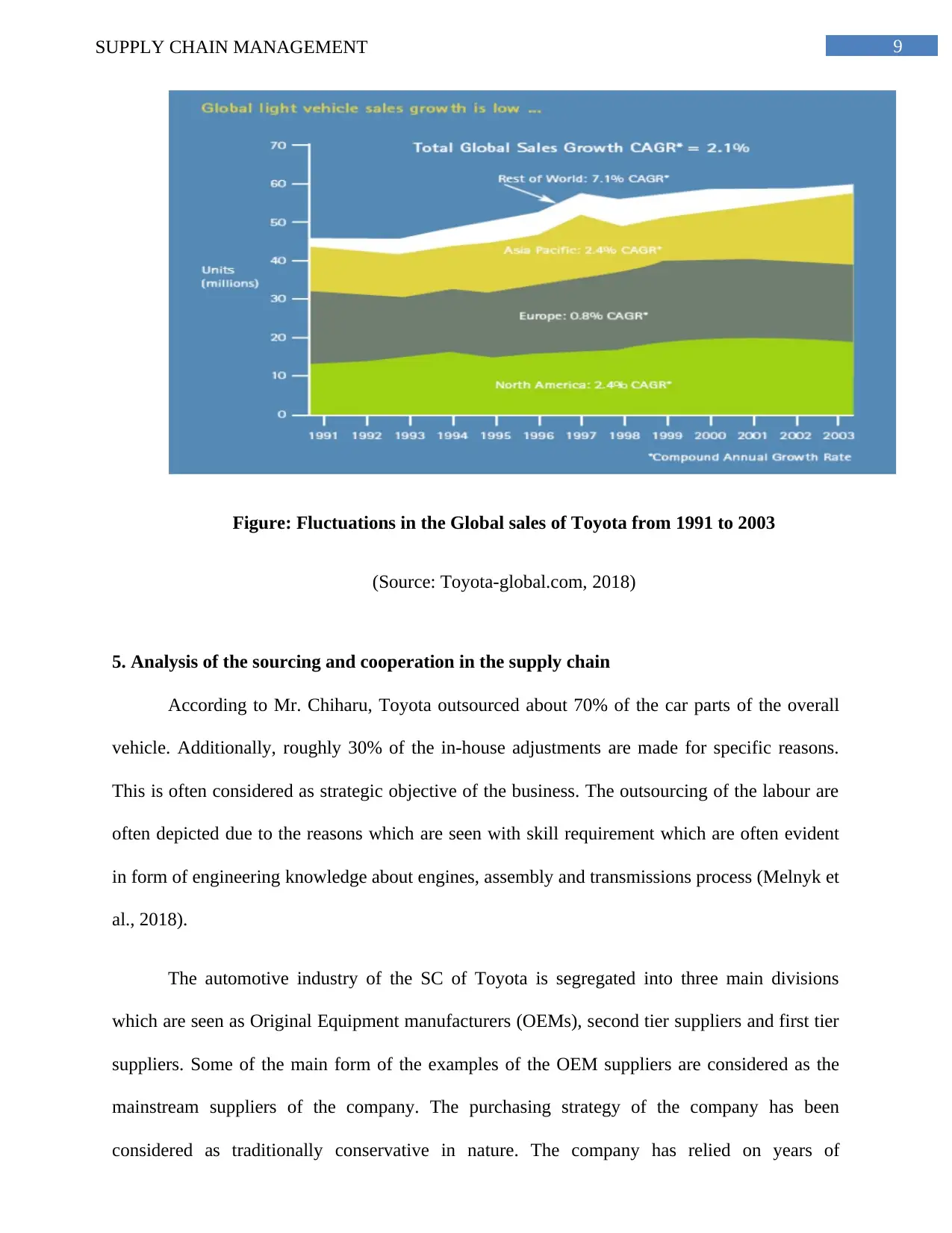
9SUPPLY CHAIN MANAGEMENT
Figure: Fluctuations in the Global sales of Toyota from 1991 to 2003
(Source: Toyota-global.com, 2018)
5. Analysis of the sourcing and cooperation in the supply chain
According to Mr. Chiharu, Toyota outsourced about 70% of the car parts of the overall
vehicle. Additionally, roughly 30% of the in-house adjustments are made for specific reasons.
This is often considered as strategic objective of the business. The outsourcing of the labour are
often depicted due to the reasons which are seen with skill requirement which are often evident
in form of engineering knowledge about engines, assembly and transmissions process (Melnyk et
al., 2018).
The automotive industry of the SC of Toyota is segregated into three main divisions
which are seen as Original Equipment manufacturers (OEMs), second tier suppliers and first tier
suppliers. Some of the main form of the examples of the OEM suppliers are considered as the
mainstream suppliers of the company. The purchasing strategy of the company has been
considered as traditionally conservative in nature. The company has relied on years of
Figure: Fluctuations in the Global sales of Toyota from 1991 to 2003
(Source: Toyota-global.com, 2018)
5. Analysis of the sourcing and cooperation in the supply chain
According to Mr. Chiharu, Toyota outsourced about 70% of the car parts of the overall
vehicle. Additionally, roughly 30% of the in-house adjustments are made for specific reasons.
This is often considered as strategic objective of the business. The outsourcing of the labour are
often depicted due to the reasons which are seen with skill requirement which are often evident
in form of engineering knowledge about engines, assembly and transmissions process (Melnyk et
al., 2018).
The automotive industry of the SC of Toyota is segregated into three main divisions
which are seen as Original Equipment manufacturers (OEMs), second tier suppliers and first tier
suppliers. Some of the main form of the examples of the OEM suppliers are considered as the
mainstream suppliers of the company. The purchasing strategy of the company has been
considered as traditionally conservative in nature. The company has relied on years of
Paraphrase This Document
Need a fresh take? Get an instant paraphrase of this document with our AI Paraphraser
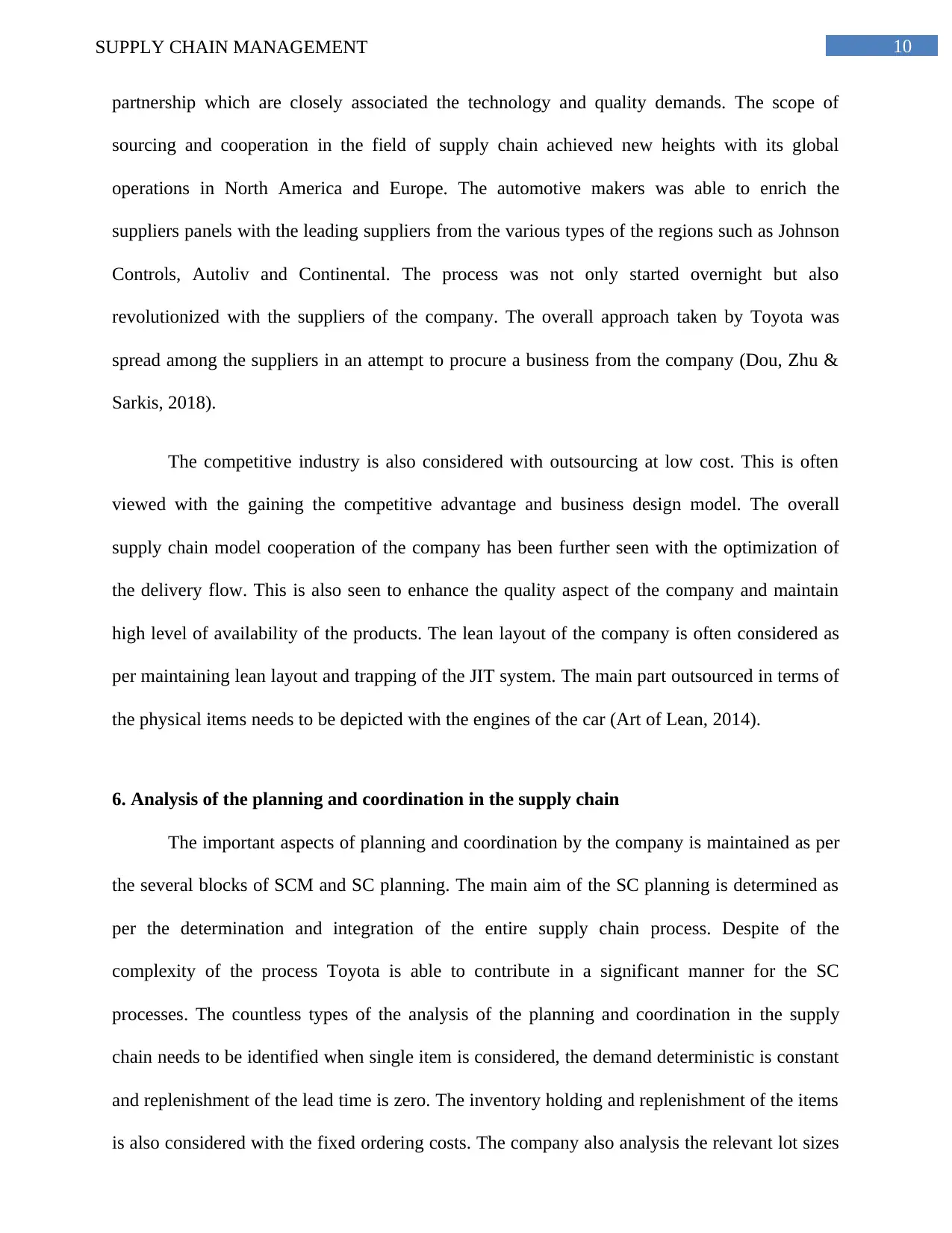
10SUPPLY CHAIN MANAGEMENT
partnership which are closely associated the technology and quality demands. The scope of
sourcing and cooperation in the field of supply chain achieved new heights with its global
operations in North America and Europe. The automotive makers was able to enrich the
suppliers panels with the leading suppliers from the various types of the regions such as Johnson
Controls, Autoliv and Continental. The process was not only started overnight but also
revolutionized with the suppliers of the company. The overall approach taken by Toyota was
spread among the suppliers in an attempt to procure a business from the company (Dou, Zhu &
Sarkis, 2018).
The competitive industry is also considered with outsourcing at low cost. This is often
viewed with the gaining the competitive advantage and business design model. The overall
supply chain model cooperation of the company has been further seen with the optimization of
the delivery flow. This is also seen to enhance the quality aspect of the company and maintain
high level of availability of the products. The lean layout of the company is often considered as
per maintaining lean layout and trapping of the JIT system. The main part outsourced in terms of
the physical items needs to be depicted with the engines of the car (Art of Lean, 2014).
6. Analysis of the planning and coordination in the supply chain
The important aspects of planning and coordination by the company is maintained as per
the several blocks of SCM and SC planning. The main aim of the SC planning is determined as
per the determination and integration of the entire supply chain process. Despite of the
complexity of the process Toyota is able to contribute in a significant manner for the SC
processes. The countless types of the analysis of the planning and coordination in the supply
chain needs to be identified when single item is considered, the demand deterministic is constant
and replenishment of the lead time is zero. The inventory holding and replenishment of the items
is also considered with the fixed ordering costs. The company also analysis the relevant lot sizes
partnership which are closely associated the technology and quality demands. The scope of
sourcing and cooperation in the field of supply chain achieved new heights with its global
operations in North America and Europe. The automotive makers was able to enrich the
suppliers panels with the leading suppliers from the various types of the regions such as Johnson
Controls, Autoliv and Continental. The process was not only started overnight but also
revolutionized with the suppliers of the company. The overall approach taken by Toyota was
spread among the suppliers in an attempt to procure a business from the company (Dou, Zhu &
Sarkis, 2018).
The competitive industry is also considered with outsourcing at low cost. This is often
viewed with the gaining the competitive advantage and business design model. The overall
supply chain model cooperation of the company has been further seen with the optimization of
the delivery flow. This is also seen to enhance the quality aspect of the company and maintain
high level of availability of the products. The lean layout of the company is often considered as
per maintaining lean layout and trapping of the JIT system. The main part outsourced in terms of
the physical items needs to be depicted with the engines of the car (Art of Lean, 2014).
6. Analysis of the planning and coordination in the supply chain
The important aspects of planning and coordination by the company is maintained as per
the several blocks of SCM and SC planning. The main aim of the SC planning is determined as
per the determination and integration of the entire supply chain process. Despite of the
complexity of the process Toyota is able to contribute in a significant manner for the SC
processes. The countless types of the analysis of the planning and coordination in the supply
chain needs to be identified when single item is considered, the demand deterministic is constant
and replenishment of the lead time is zero. The inventory holding and replenishment of the items
is also considered with the fixed ordering costs. The company also analysis the relevant lot sizes
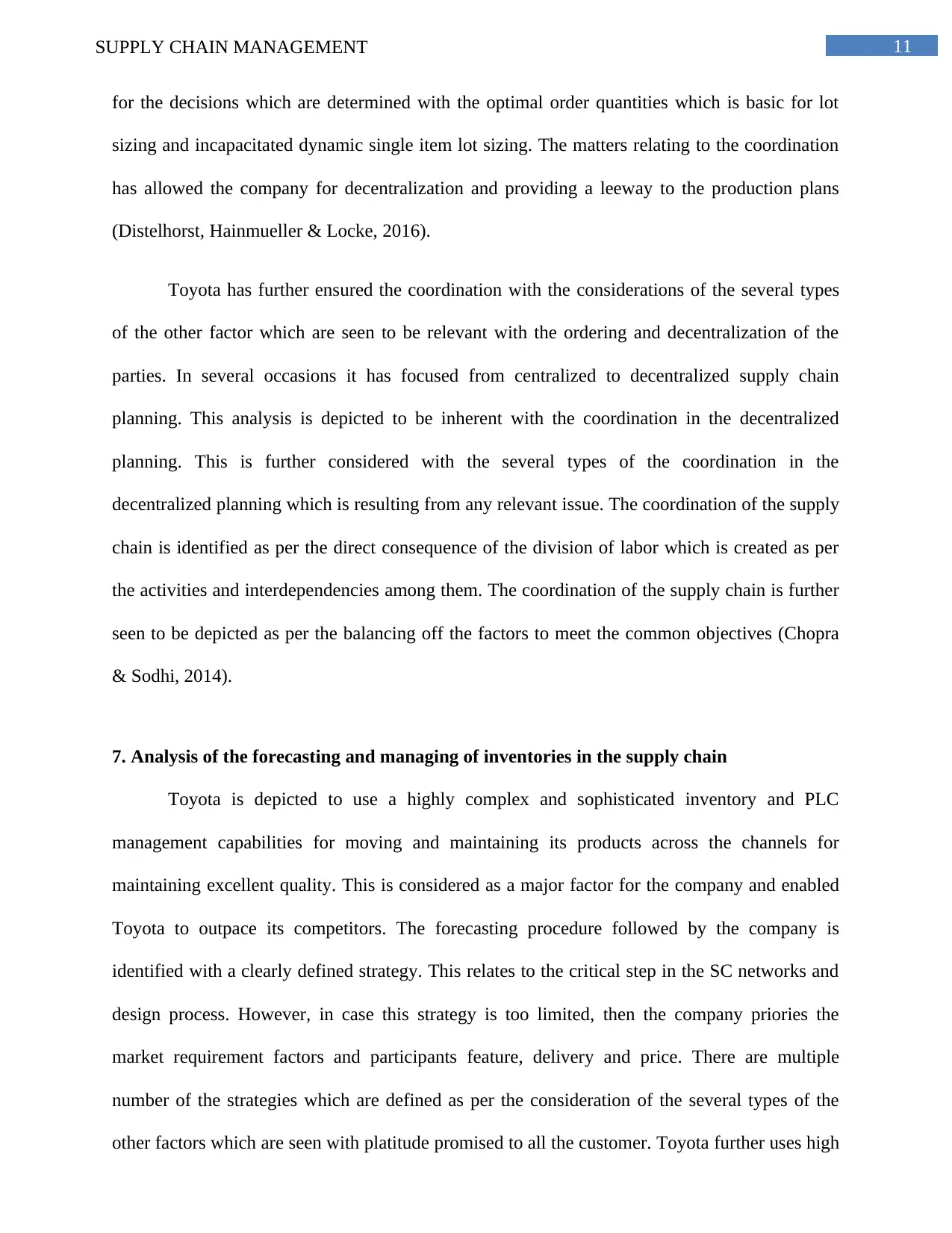
11SUPPLY CHAIN MANAGEMENT
for the decisions which are determined with the optimal order quantities which is basic for lot
sizing and incapacitated dynamic single item lot sizing. The matters relating to the coordination
has allowed the company for decentralization and providing a leeway to the production plans
(Distelhorst, Hainmueller & Locke, 2016).
Toyota has further ensured the coordination with the considerations of the several types
of the other factor which are seen to be relevant with the ordering and decentralization of the
parties. In several occasions it has focused from centralized to decentralized supply chain
planning. This analysis is depicted to be inherent with the coordination in the decentralized
planning. This is further considered with the several types of the coordination in the
decentralized planning which is resulting from any relevant issue. The coordination of the supply
chain is identified as per the direct consequence of the division of labor which is created as per
the activities and interdependencies among them. The coordination of the supply chain is further
seen to be depicted as per the balancing off the factors to meet the common objectives (Chopra
& Sodhi, 2014).
7. Analysis of the forecasting and managing of inventories in the supply chain
Toyota is depicted to use a highly complex and sophisticated inventory and PLC
management capabilities for moving and maintaining its products across the channels for
maintaining excellent quality. This is considered as a major factor for the company and enabled
Toyota to outpace its competitors. The forecasting procedure followed by the company is
identified with a clearly defined strategy. This relates to the critical step in the SC networks and
design process. However, in case this strategy is too limited, then the company priories the
market requirement factors and participants feature, delivery and price. There are multiple
number of the strategies which are defined as per the consideration of the several types of the
other factors which are seen with platitude promised to all the customer. Toyota further uses high
for the decisions which are determined with the optimal order quantities which is basic for lot
sizing and incapacitated dynamic single item lot sizing. The matters relating to the coordination
has allowed the company for decentralization and providing a leeway to the production plans
(Distelhorst, Hainmueller & Locke, 2016).
Toyota has further ensured the coordination with the considerations of the several types
of the other factor which are seen to be relevant with the ordering and decentralization of the
parties. In several occasions it has focused from centralized to decentralized supply chain
planning. This analysis is depicted to be inherent with the coordination in the decentralized
planning. This is further considered with the several types of the coordination in the
decentralized planning which is resulting from any relevant issue. The coordination of the supply
chain is identified as per the direct consequence of the division of labor which is created as per
the activities and interdependencies among them. The coordination of the supply chain is further
seen to be depicted as per the balancing off the factors to meet the common objectives (Chopra
& Sodhi, 2014).
7. Analysis of the forecasting and managing of inventories in the supply chain
Toyota is depicted to use a highly complex and sophisticated inventory and PLC
management capabilities for moving and maintaining its products across the channels for
maintaining excellent quality. This is considered as a major factor for the company and enabled
Toyota to outpace its competitors. The forecasting procedure followed by the company is
identified with a clearly defined strategy. This relates to the critical step in the SC networks and
design process. However, in case this strategy is too limited, then the company priories the
market requirement factors and participants feature, delivery and price. There are multiple
number of the strategies which are defined as per the consideration of the several types of the
other factors which are seen with platitude promised to all the customer. Toyota further uses high
⊘ This is a preview!⊘
Do you want full access?
Subscribe today to unlock all pages.

Trusted by 1+ million students worldwide
1 out of 23
Related Documents
Your All-in-One AI-Powered Toolkit for Academic Success.
+13062052269
info@desklib.com
Available 24*7 on WhatsApp / Email
![[object Object]](/_next/static/media/star-bottom.7253800d.svg)
Unlock your academic potential
Copyright © 2020–2025 A2Z Services. All Rights Reserved. Developed and managed by ZUCOL.





